BREAKING: DOCTOR HELEN HUSTON, one of Canada’s best-known missionaries, died peacefully in Edmonton on March 1st, 2024.
The ‘Good Doctor’ — who built a hospital on the side of a mountain in Central Asia — was 96.
Go to the bottom of this post for more on Doctor Huston’s final hours … and funeral details.
It was only a few years ago, at least it seems that way, but it was nearly half a century.
In 1981 I travelled to Nepal for a magazine story on a unique Canadian missionary — a medical doctor — who ran a small hospital high above the clouds in the foothills of the Himalayan Mountains.
Please join me as I recall that special reporting assignment … [click on images to enlarge]
Like some assignments, this one was so cool in so many ways. It was full of rewards that would sparkle forever.
The remarkable story of ‘Doctor Helen’ took up four pages of Today Magazine, a supplement to the major newspapers in Canada in the 1970s and 80s. With the highest circulation of any publication in Canada, Today was ‘King.’ The article, read by millions, is coming right up …
Helen Isabel Huston [pronounced: Houston, like the city] was born in Innisfail, Alberta on September 20th, 1927. Helen’s mother was a school teacher; her father a United Church minister.
Because her family was always on the move, Helen grew up in several small communities across Alberta. A highlight of her teenage years was attending a Christian youth camp, Canadian Girls in Training, better known by its initials: CGIT.
Helen Huston graduated from medical school at the University of Alberta in Edmonton in 1951, becoming one of Canada’s first female doctors. She interned at the Royal Alexandra Hospital in Edmonton and at the Vancouver General Hospital.
Once Huston became a full-fledged doctor, she had some big decisions to make. The most paramount — as in, what to do with her life? — was easy. She decided to follow her heart and become a ‘servant of the Lord.’ And she figured the best way to do that was to help the sick and dying in the poorest parts of the world.
The young physician would become a missionary. To use a ‘Helen-ism’, “Her heart was on fire for Jesus.”
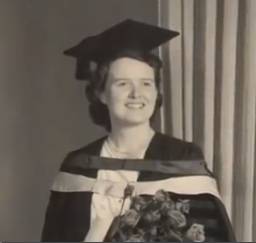
Helen Huston – 1951 [supplied]
She spent five years in India, then moved 800 miles north — to Nepal — where she worked at a small cholera clinic on the outskirts of Kathmandu, the capital.
The Canadian doctor arrived in Nepal at a time when it was known as the ‘forbidden kingdom,’ since very few foreigners were allowed in.
Her clinic was run by the United Mission to Nepal [UMN], an ecumenical organization headquartered in Kathmandu.
In the 1960s, ‘Doctor Helen,’ as she became known, traveled to western Nepal and to Amp Pipal, a sprawling Nepalese village of thatched-roof huts in the shadow of Liglig [Liglikot] Mountain — and the world’s tallest peaks, the Himalayas.
There, “in the sticks,” Huston worked at a small medical clinic. Word soon spread about the care available at the clinic and it wasn’t long before staff could no longer cope with the crush of patients. A new, larger facility was desperately needed.
Like the white clouds that roll into Amp Pipal, the money suddenly appeared to make it all happen.
Back in Alberta, a farmer was listening to a church radio broadcast where the topic was a unique hospital project in faraway Nepal. The man was touched by what he heard, and he fired off a cheque for $1,000.
Huston sent the farmer a thank you note. The Good Samaritan in Alberta responded by sending a further $9,000.
Gerald Hankins of Calgary — who had been in Helen Huston’s medical class — also raised money for the new hospital.
Helping out as well was Doctor Carl Friedricks of the UMN Hospital in Tansen, about four or five days’ walk south of Amp Pipal. An additional $10,000 had been raised for the building of the Tansen Hospital and so the extra money was forwarded to Amp Pipal.

Doctor Helen in her early days at Amp Pipal. [Supplied]
Huston was an exceptional physician, hospital administrator, and Christian. She was also exceptionally modest.
Months would pass before she read the magazine story, partly because she was living in a remote village on the other side of the world and the mail took a while to get there. Mind you, this was decades before computers, the Internet and smartphones.
But the main reason the good doctor held off reading the story was that she feared it did not give full credit to the Lord. This was important to her. Huston wanted little or no recognition, and certainly no glory. This physician clearly wanted to be under the radar.
Huston’s friends and colleagues assured her the publicity was fine and she shouldn’t worry about it. Good for the cause, they said, adding it was positive PR for the United Mission to Nepal.
Even so, the doctor who’d been tagged with the moniker of a ‘female Albert Schweitzer’ remained skeptical.
This post is about: a] the backstory behind the 1981 magazine article … and b] what has since happened to both Doctor Huston and her hospital in Nepal.
Note: unless otherwise specified, all images in this post are from 1981.

With the help of a telephoto lens, a view of the Himalayan Mountains from Amp Pipal. Pictured is Mt. Manaslu … at 26,781 feet, the eighth tallest mountain in the world. In the foreground is part of Huston’s hospital. [Photo by Author]
HELEN HUSTON TODAY
Where is Doctor Helen Huston today and what is she up to?
Huston turned 94 in September 2021. She lives in an assisted-living senior’s centre in South Edmonton, Alberta.
Long retired from the medical profession, Huston now needs medical care herself. The woman who once ran effortlessly up rock-strewn trails in Nepal is now ‘on in age’ and living in Big City, North America.
With the help of a walker, Huston today gets around slowly, one step at a time. Until late 2015, she’d been living on her own in a 2-bedroom apartment near the university.
Aches and pains aside, the former missionary doesn’t seem to fret about getting older. Old age is a privilege denied to many and she’s happy she can still do some church work. More on that coming up.
Let’s begin by slipping back to the early 1980s when the ‘Doctor Helen’ story appeared on the pages of Today. To read the article, just click on the pages.
TODAY MAGAZINE
Today arrived with the Saturday edition of:
- The Toronto Star
- The Gazette [Montreal]
- The Vancouver Sun
- The Edmonton Journal
- The Citizen [Ottawa]
- Winnipeg Free Press
- The Calgary Herald
- The Spectator [Hamilton, Ontario]
- The London [Ontario] Free Press
- Times-Colonist [Victoria]
- The Daily News [St. John’s, Newfoundland]
- The Telegraph-Journal [Saint John, New Brunswick]
- The Whig-Standard [Kingston, Ontario]
- The Standard [St. Catharines, Ontario]
- The Brantford Expositor [Ontario]
- The Lethbridge Herald [Alberta]
![Today Magazine sent me about half a dozen letters from people who read the article, and wrote them about it. Above: a letter from Islington [Toronto] .](https://byronchristopher.files.wordpress.com/2014/08/huston984.jpg?w=450&h=480)
Today forwarded about half a dozen letters from readers. Above: a letter from a woman in Islington, Ontario [Toronto]. Notice her concern about corruption in Nepal. Click to enlarge.
WHAT HAPPENED TO THE LITTLE GIRL IN THE STORY …??
At the very end of the article, there’s an account of a young girl, in extreme pain, being carried up a mountain path to the foreigner’s hospital. Today readers wanted to know what happened to her. Did she make it?
At the time I wrote the story, I had no idea.
Turns out, the girl lived. Her appendix had ruptured but the doctors in Amp Pipal were able to save her. She may be a grandmother by now, who knows?
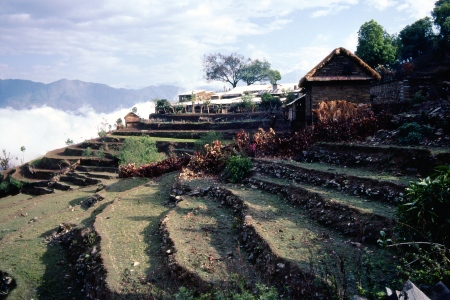
Above the clouds: the foreigner’s hospital at Amp Pipal. [Photo by Author]
THE DEATH OF MOON LOVE
Moon Love was the name of the baby Nepalese girl who died from pneumonia. I’d reported that her remains were set on fire after being doused with gasoline. Not gasoline, says a development worker who worked for many years in Nepal. He points out the fuel used in that part of the country [where there were so few vehicles] would likely have been kerosene, not gasoline. A small point, yes, but for three decades it has bugged me that I didn’t get it right.
Also, an official with the Canadian International Development Agency [CIDA] objected to the comment that seeing a witch doctor had been ‘a waste of time,’ as his agency was trying to work more closely with local medicine people.
This didn’t bother me at all, to be frank. Turns out, dealing with a witch doctor had sometimes been a deadly waste of time.
A SECOND HOSPITAL DEATH
With any reporting assignment, there’s always information that doesn’t appear in the finished product — usually because of a lack of space [sometimes the piece needs to be cut to make room for advertising]. In any case, editors at Today in Toronto eliminated the story of the death of a second child at Huston’s hospital.
Here’s what happened: a boy, about seven or eight I figure, was being operated on which required him to be put under. To everyone’s surprise, he died suddenly on the operating table. Did the anesthetic cause his heart to stop? No idea.
I was walking around the Amp Pipal Hospital with my camera when I stopped in my tracks outside an operating room. The door was wide open and I could see a doctor pumping frantically on a boy’s chest. The youngster was on a table and his legs jerked with every shunt.
The doctor said not a word — but his eyes, appearing above a surgical mask, screamed, “Trouble!!!”
Even so, I didn’t think a whole lot about it and I went on my way.
I returned shortly after to see a dozen patients and visitors standing in a large semi-circle outside the room. They were staring at the boy’s mother who had her back to the wall and was wailing, just giving it, tears streaming down her face.
No one was within six feet of her. Totally distraught, the mother slowly slid down the wall and laid on the floor where she continued to sob uncontrollably. Nobody moved. No one walked over to help; we all stared in disbelief.
Nobody seemed to know what to do, myself included.
I raised my camera to get a photo of the spectacle, but a man standing to my left gently nudged me in the ribs. He spoke not a word but shook his head from side to side. I got the message and lowered my camera.
In my mind, I have replayed many times the scene of a young woman sliding down the wall in slow motion, her face contorted with unimaginable grief. It’s one image I can’t get out of my head.
HOW THE HUSTON STORY CAME ABOUT
Since my early 20’s I’ve had an interest in international development, once known as ‘foreign aid.’
Part of the appeal, I admit, had to do with traveling to faraway lands. The poorer these countries were, the more my curiosity was piqued. I wondered if the locals could be lifted out of the mess they were in.
Perhaps that’s too condescending coming from western white folk, like me, but there you go …
Nepal held more appeal than most countries because of its majestic Himalayan Mountains, those ‘aluminum sentinels’ as someone once described them, Mt. Everest and all that. Another reason I was interested in the small, land-locked country was that as recently as the 1950s, Nepalis had no contact with the outside world.
I remember reading about Nepal when I was a kid. It was a fascinating, mysterious place and I wondered how people living there got by.
And of course, Nepal was where medical missionary Helen Huston hung her hat.
I made it my goal to meet her and do a story on her.
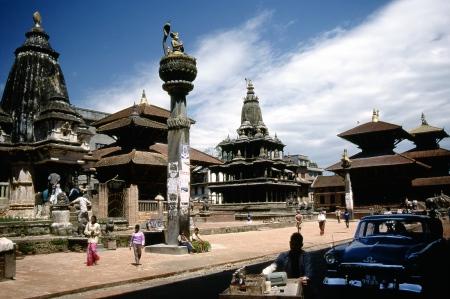
1981 – Nepal – “The Forbidden Kingdom” [Photo by Author]
I fired off a letter to the good doctor, letting her know that I planned to travel to Amp Pipal to do a magazine story on her. For the life of me, I can’t remember if she even replied. Don’t think she did.
I bought airline tickets anyway and flew from Edmonton to Kathmandu with stops in Toronto, Frankfurt and New Delhi.
DOCTOR HELEN’S FATHER
Before leaving for Nepal, I traveled to Camrose, an hour’s drive southeast of Edmonton, to interview Helen’s father, William [Wil] Huston, the former preacher.
Camrose is a pleasant community — and a very giving one: in the early 1980s, it had the highest foreign-aid donation per capita in Canada. Bet you didn’t know that.
Wil and I hit it off. His eyes sparkled when he talked about his missionary daughter in Nepal. He was especially proud of what Helen had accomplished.

William Huston at his nursing home in Camrose in 1981. I told him I was coming and he got all dressed up. [Photo by Author]
Helen’s ‘apostle seed’ was planted when missionaries visited the Huston Family in Innisfail, Alberta, with spell-bounding accounts of their work in far-distant lands. The kid was hooked.
Will never got to Amp Pipal, but Edith did. By the time I got involved in researching Helen Huston, Edith had passed on. To use another Helen phrase, she’d ‘gone to Glory.’
DEALING WITH THE MEDIA
I pitched the Huston story to three magazines: Today [Toronto], Reader’s Digest [Montreal] and Western Living [Vancouver]. Each expressed interest.
Even though the Digest offered more money, I chose Today because it simply had more readers.

Mount Everest is the tall peak on the right. [Supplied]
I then did a lengthy item for Broadcast News, the wire service and audio arm of The Canadian Press … plus a magazine piece for Western Living on the joys and perils of hiking in Nepal.
Did I miss anyone? Oh yes, a story for a newspaper in Chicago, another for a paper in West Germany — and for a group of Alberta churches and development groups, a slide show on foreign development in Nepal.
Anything to cover expenses and make a little coin.
ITV EDMONTON
When shopping the Huston story around, I saw the best — and the worst — of my profession, the media.
I approached ITV [now Global Television] in Edmonton about working with them to produce a feature on the unique Alberta missionary, the ‘female Albert Schweitzer.’ A honcho there was most interested in the story. We had several meetings on how to pull this off.
I shared with him everything I knew about Doctor Huston. The man got a goldmine of information for our documentary … plus all my contacts with phone numbers.
I was being used.
I was initially slated to be a producer, but the boss at ITV soon changed that to co-producer. At the next meeting, I was further downgraded to a writer — and even that was eventually downgraded to ‘thanks for the story idea, but we’re doing this without you …’ The way the boss put it, I’d given ‘birth’ to the project but the child had now grown and ITV was now caring for it. Corporate sleaze at its finest.
What a disappointment that was. And here we were, focusing on a Canadian who had exceptional “Christian values.”
I also discovered that ITV had contacted Canadian Save The Children, a non-governmental foreign development agency based in Toronto. The TV station wanted the charity to pay for their flights to and from Kathmandu. I’m not making that up.
A call to a contact at Save The Children scuttled that plan. ITV was then eliminated from the project.
Months later, I personally delivered more free ‘research material’ to ITV Edmonton — a copy of Today Magazine that had the 4-page spread on ‘Doctor Helen.’ The TV station never did get to see Helen Huston at work in Nepal. Karma.
MUSIC FROM NEPAL
Care for a little music from Nepal?
Here are Bharat Nepali, J.B. Lama and Bharat Budhathoki and “Magic of the Himalayas.” The number, which I came across on iTunes, runs 6:10.
KATHMANDU, CAPITAL
In the spring of 1981, I flew to Nepal with a portable Sony stereo tape deck, extra batteries, two Canon 35mm cameras, a few lenses, some ultraviolet filters, plenty of slide film … and as many background notes as I could muster.

Kathmandu, Nepal [Photo by Author]
I ended up buying a miniature khukuri knife, which I still have. It’s my letter opener.
I had been well advised by a foreign aid worker in Central America that when in the Third World, avoid flavoured ice-water treats. She called them ‘cholera on a stick.’
Another memory I have of Kathmandu was that one ounce of marijuana sold for $1.00 U.S. No, I didn’t buy any, although Canada Customs thought perhaps I had. When I landed in Toronto, they went through my luggage with a fine tooth comb … simply because I was returning from Nepal.
Makes sense, I guess. If I worked in Customs I’d be doing the same thing.
ESCAPE ARTISTS
For thousands of years, it was perfectly okay to smoke pot in Nepal. As in legal.
Only in the 1960s when the American hippies invaded Nepal and spent their days at the temples downtown getting stoned, picking their noses and contemplating the meaning of life — did the authorities in Nepal make smoking pot semi-illegal.

Hubble Bubble and the Dreamy Room. Kathmandu. [Photo by Author]
FROM KATHMANDU TO AMP PIPAL

The village of Amp Pipal is northwest of Kathmandu in the Gorkha Region. [Map courtesy of Nations Online Project.] Note that by clicking on the map, the image will become larger — but if you’re still listening to ‘Magic of the Himalayas,’ it may also stop the music.
I sat at the back of the bus, in the corner. I yanked the window up for fresh air and to take some photos.
I’d read stories about people in places like Pakistan and Nepal who died when their bus veered off a mountain road. I thought, how does that happen?
On the ride to Dumre, I got the answer. No guard rails!! Passengers sitting on the roof of the bus not only had the best view but the best chance of surviving if we blew a tire and went airborne.
Turns out, the bus ride gave one Nepali teen motion sickness. Poor kid. The youngster got sick and with the bus bouncing along at a good clip, he darted to the nearest open window — mine — just getting his head out the window when he vomited.
I held up my attaché case to protect myself from the spray. That took care of my urge for a snack.

No guard rails: leaving Kathmandu and traveling west towards Dumre. [Photo by Author]

Dumre. From here I rode in the back of an old Land Rover to a suspension bridge. That was one bumpy ride. [Photo by Author]
For some locals, that’s how they made their living. Up and down those trails, rain or shine.
They carried the loads on their backs, in large sacks held in place by a wide strap across their forehead. Some women had carried loads for so long that their skulls were permanently indented. Crazy.

The suspension bridge after the Jeep ride from Dumre. I was the last of our group to cross this bridge … because I’d been taking photos. A youngster at the end of the bridge decided to have a little fun, at my expense. He started to jump up and down on the bridge — laughing all the while — causing the bridge to buckle, like an ocean wave. I braced myself as best I could and held onto my camera gear. Fun times. [Photo by Author]

In rural Nepal, foreigners were an unusual sight. Children in this village came running to check us out. What was so different about us? We were white. [Photo by Author]
SPRAWLING HOSPITAL COMPLEX AT AMP PIPAL
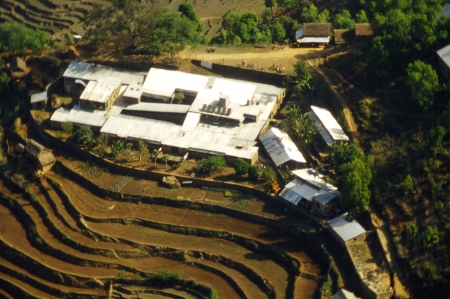
Huston’s home was to the right [out of picture], part of a cluster of small missionary houses. She recalls the heavy monsoon rains filling up the terraces and hearing the sound of the water spilling from a terrace to the one below. Crops, such as rice, are grown on the terraces. [Photo by Author]

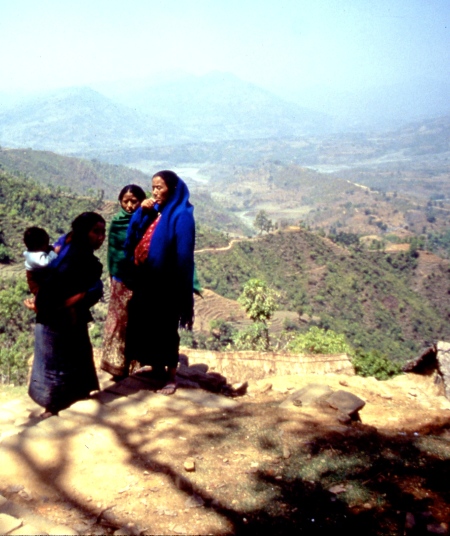
Patients arrived at the Amp Pipal Hospital from distances like those shown in this photo [notice trail]. Some traveled from much further away. [Photo by Author]
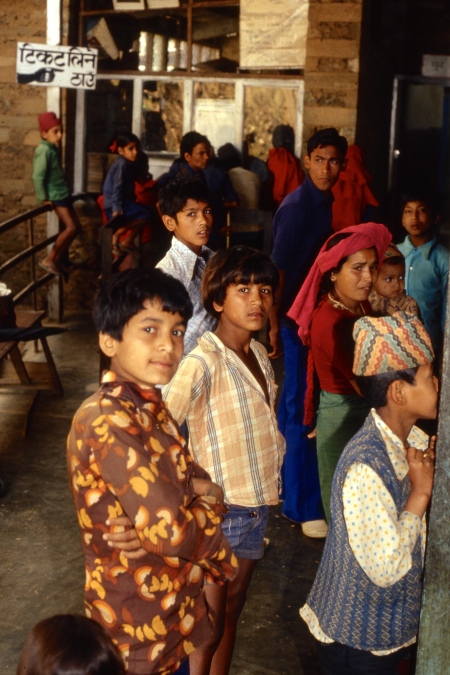
The front entrance of the hospital. The sign points the way for outpatients who have tickets. [Photo by Author]

DOCTOR HUSTON’S HOME
Helen Huston occupied the top floor of this two-story house which she shared with a young nurse from New Zealand.

Doctor Helen and I spent some time on her balcony talking about her work and the challenge of dealing with so many patients. [Photo by Author]
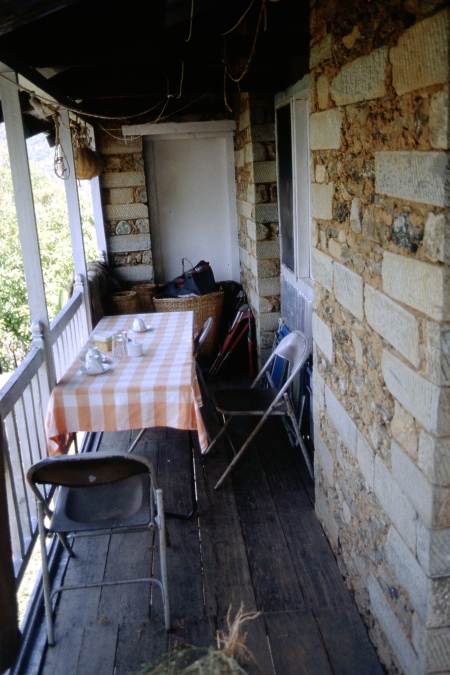
The balcony where I interviewed Doctor Huston. This is where we were sitting when the call came in from the hospital about the death of Moon Love, the dehydrated infant. Moon Love is mentioned in the Today story. [Photo by Author]

Ta Ta, Helen Huston’s close and loyal friend at Amp Pipal. Less than a month after Doctor Huston left Nepal to return to Canada, the Nepalese woman died [1993]. ‘Ta Ta’ means ‘Older Sister.’ I believe Ta Ta and Helen were soul-sisters. [Photo by Author]

Helen Huston and her roommate, Kathy Crombie of New Zealand. Crombie — with a Doctorate of Education under her belt — is now a Captain with the Salvation Army in Sydney, Australia. Last I heard, Kathy was helping the poor in New York City. The cabinet directly behind the women is where some food was kept. To keep the food safe from ants, the cabinet legs were placed in small tins of water. It worked. There was a lot of improvising going on at Amp Pipal. [Photo by Author]
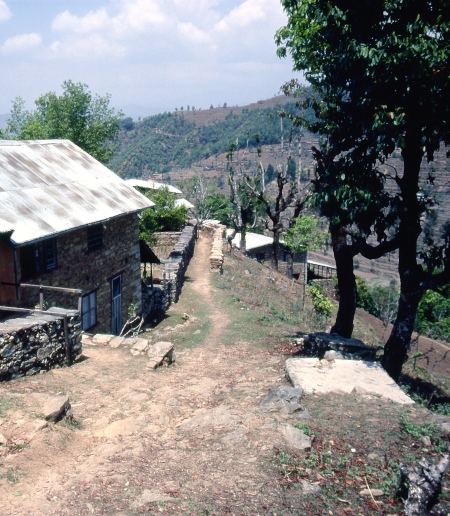
The original clinic at Amp Pipal. The clinic closed when construction of the hospital was completed in 1969. When this shot was taken [1981], it was the living quarters for missionary teachers. [Photo by Author]
“With the most slender of facilities, they did their best to care for a seemingly-endless procession of village peoples who had nowhere else to go. Only their unshakeable faith in God kept them going; they believed strongly that God had called them to this work and therefore they would try their best.” – Gerald Hankins
Hankins wrote a book called A Heart for Nepal about his good friend. “Helen Huston,” he says, “personifies the great Christian virtues of generosity, humility, thoughtfulness, and grace.”
DOCTOR HUSTON & STAFF AT WORK
Doctor Huston was one busy lady. She was usually up early and when she returned home from the hospital, depending on the hour, she used a flashlight to help show the way.
Here are some photos of Huston at work and of the Amp Pipal Hospital …

Tek Bahadur broke his back after he fell from a tree trying to get leaves to feed his animals. He is now married and lives and works in Kathmandu. Tek gets around with a bicycle specially designed for him. [Photo by Author]
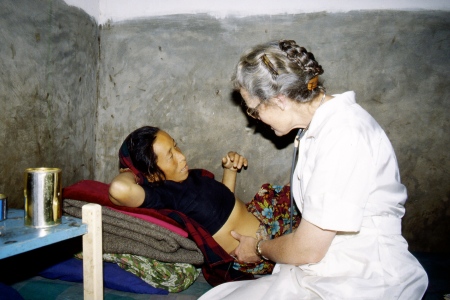
There are no roads in Amp Pipal and so people must walk [or be carried]. Distance is not measured by miles or kilometers. It is measured by time. ‘So-and-so lives two days’ walk away,’ etc. [Photo by Author]
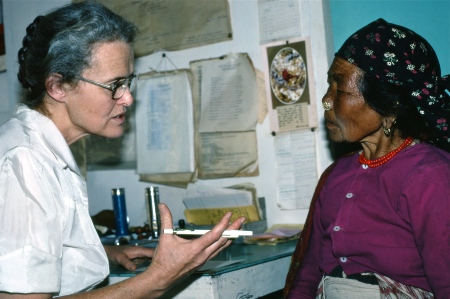
This was the image Today used … Doctor Huston talking to a patient in her office. The woman was from another village. She made her way to the hospital to have a large, dead insect removed from her ear. [Photo by Author]

In the early 80s, most of the surgery at Amp Pipal was done by Doctor Tom Hale of New York State. Hale also served with the U.S. Army in Vietnam. Here, he’s about to perform cataract surgery. [Photo by Author]


Half of Amp Pipal Hospital’s ambulance system … [Photo by Author]

Doctor Huston doing her rounds. In 1994, Huston was also awarded The Alberta Order of Excellence, in part for her 32 years’ service at Amp Pipal. [Photo by Author]

The tuberculosis ward at Amp Pipal. Each unit on the ward has its own mud-stove. TB is an infectious bacterial disease that was widespread in the 19th century. It still kills millions a year in developing countries. [Photo by Author]
HOSPITAL STAFF
Trained Nepalese staff took pride in having a hospital job — and wearing a nurses’ uniform.

Relaxed: patients and visitors often mingled with hospital staff. This staff member is on his way to the pharmacy. [Photo by Author]
FOREIGN TEACHERS AT AMP PIPAL
Some of the best “unsung” heroes in our lives are teachers. That’s the way I saw things and I suspect the children of Amp Pipal were no different.
Here are two outstanding teachers who served well at Amp Pipal … Tony Bouverie-Brine of England and Else Furthmüller of Germany. Photos by Author.


The school at Amp Pipal. There was no door [children climbed in through the windows!] — and there were no desks. Scribblers and books were placed on the students’ knees. [Photos by Author]
THE CHILDREN …
I get along well with children. I enjoy their company; the ‘drawing card’ being their kindness and innocence. Dealing with the kids in Nepal, I was quickly reminded that laughter is the same in any language.
It was a privilege for the children of Amp Pipal to be able to go to school. Think about that for a moment.
The youngsters around the hospital took delight in playing with simple things, such as an empty film container … or having a souvenir pin from a country they’d never heard of.




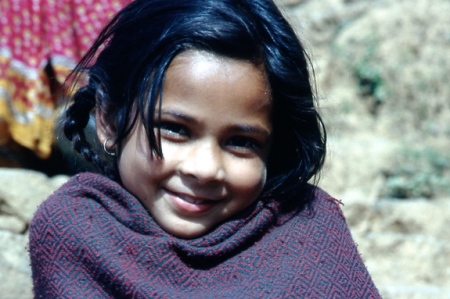

The children managed to stay still long enough for this group shot. No language barrier here … [Photos by Author]
THE AMP PIPAL CHILDREN TODAY
I’ve often wondered what became of these kids. Did they stay in Amp Pipal? Did they move to Kathmandu … or did they leave the country? What are they doing now?
Thanks to Chris Hale — son of U.S. surgeon Tom Hale, mentioned above — I was able to track down two of the children. In 1981 — the year I wrote the Today story — Chris was 13 and living in Amp Pipal with his missionary parents.
The boy in the centre of the above photograph is Yam Bahadur Thapa who went on to study at a technical school in Singapore. He and his wife Niru have a daughter; the family lives in Kathmandu. Check out Yam’s Facebook page: https://www.facebook.com/yam.thapa.7505?fref=ts
Yam’s younger sister, Sona [far left in the group photo] is married and also lives in Kathmandu. Here’s her Facebook page: https://www.facebook.com/sona.thapa.7?fref=pb&hc_location=friends_tab&pnref=friends.all
And where is Chris Hale, you ask? Hale, an accomplished musician, lives in Toronto. His website: http://christopherhalesitar.com
OLD HOME MOVIE FILM – 1970s & 80s
Here is some Super 8 film shot by the Hale family in Amp Pipal in the 1970s.
The beautiful background music [Himalchulu, a Nepali Christian folk song] is performed by Chris.
https://www.youtube.com/watch?v=WvEkWBQnw_4
Here’s a short video clip of Doctor Helen at work [courtesy of Esa Ahonen of Finland].
MY HOME WHILE IN AMP PIPAL
I stayed in a small house at the missionary compound, which surrounded the hospital and the school. As you can tell by the photo, my unit was spartan … but clean and orderly. Nice and peaceful, just the way I like it.
I didn’t spend much time there, except to sleep, go through my notes and clean my equipment. I was usually out doing interviews and taking photos.
The house was normally occupied by a young missionary from Finland, but she was on furlough [leave]. Her Canadian husband, Norm, from Ontario, worked at Amp Pipal on a water cleaning project. Norm was a good fellow.
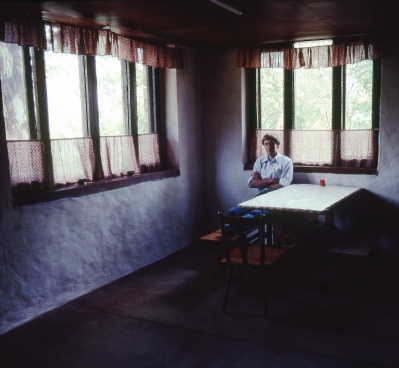
Author and the cabin where he stayed in Amp Pipal in 1981. [Photo by Author]
Tony was an avid photographer. We took a lot of photos. Tony took delight in showing me the small, wood-burning stove he’d made — from mud. Again, the folks in Amp Pipal — whether local or foreign — improvised to get by.
Tony eventually returned to Britain. Last I heard he was back in Nepal, doing foreign-development work in Kathmandu.
Else, a gifted communicator and humanitarian, returned to Germany, married a preacher and had two children. Else usually sends an email at Christmas and when we get together in Germany, she makes a wonderful meal and her hubby pulls out some good German wine.

To the right is the school at Amp Pipal, where classes were taught by foreign missionaries who had learned the Nepalese language. [Photo by Author]
When I realized it was an earthquake, I tried to make my way to the bathroom [I’d read that of all the rooms in a house, the bathrooms were the safest during an earthquake because of the plumbing] … but I couldn’t walk; it was as though I was drunk. The tremors suddenly stopped, and for a moment all was quiet.
Then the dogs started barking.
Damage at Amp Pipal was limited to a cracked concrete foundation. I can’t recall where the epicentre was located.
One evening, Tony and I got talking way too much … and by the time I hauled out of his place, it was very dark. Pitch dark. No street lights, remember. Not to worry. I had my trusty flashlight.
But I came to a fork in the road — but took the wrong path. I was lost. I spotted what I thought was my house and cut through the bushes — unaware of what was ahead — and I tumbled down a steep embankment, cutting my arm.
It was more embarrassing than anything. I eventually made my way to the house … but being a closed, missionary compound, news of a reporter getting lost and taking a tumble spread like wildfire. The locals loved it.
The good news is that I didn’t have far to go to get patched up.
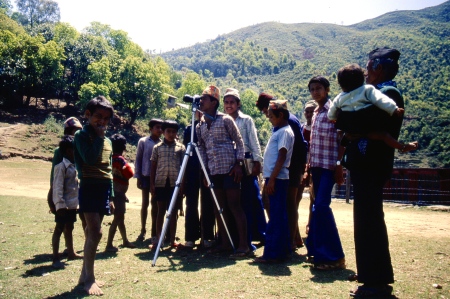
Locals line up to see what Lig Lig Mountain looks like through a camera’s telephoto lens. [Photo by Author]

A religious painting near the main entrance of the hospital at Amp Pipal. [Photo by Author]
POLITICAL UNREST & CONFLICT
When I was in Nepal [Spring 1981], Maoist rebels were active in the western part of the country and they organized a day of protest. There was to be a total work stoppage — and I mean ‘total.’ No one was to work that day; there was none of this ‘essential services’ stuff.
Doctor Huston knew the protest was coming [there is a reference to her thoughts about the demonstration in the magazine story]. To make sure I wasn’t around to see any conflict at the hospital, she scurried up to my house at five in the morning — with a packed lunch. “Byron,” she said, rousing me from a deep sleep, “today’s a great day to climb Liglig!!”
I shook the cobwebs from my head, grabbed my camera gear and off I went.
I hadn’t walked very far when I was surrounded by a group of more than a dozen men, most in their 20s. Oh oh. Trouble. Protestors. And some were ticked. A man I took to be the leader stood on a rock as high as a one-story house and, like a Hollywood stuntman, jumped to the ground, regained his balance and walked straight towards me. He was definitely on a mission, no pun intended.
His eyes remained fixed on the foreigner with all the camera gear.
The protestors gave the man a look of respect, stepping aside as he made towards me. The rock jumper stood directly in front of me and began his lecture. I knew virtually no Nepalese, but his glare and the tone of his voice clearly signaled he was not a happy camper. He was trying to tell me I wasn’t supposed to be working.
Mimicking with my hands — even worse than an Italian with a twitch — I indicated that I was climbing Liglig to get some pictures. I then tried to leave, but Mr. Jumper blocked my path by extending his arm. I looked around, saw that no one had weapons and so I clutched his arm and slowly lowered it. He didn’t resist, nor did he say anything.
In the end, there wasn’t much of a confrontation. As I made my way through the crowd, some of the protestors looked at one another with puzzled faces as if to say, “Well, what do we do now? …” Or, maybe they said, “Holy Budda, this guy is as dumb as a sackful of hammers.”
I continued down the trail and did not look back. I was a bit worried, I admit, but did not want to show it.
I’m not sure I’d behave the same way today.
I hadn’t walked for more than 20 minutes when I heard the sound of baseball-sized rocks bouncing off the ground. The stones were missing the target — and I was the target. “What the hell is going on?” I wondered. The assailant was an older woman, and she was standing about 50-60 feet away. She was some ticked. The old gal screamed and hurled rocks as fast as she could pick them up.
She was either part of the rebel group or a wannabe. Or, who knows, she may have been frustrated at having been cut by the New York Yankees. The good news was that her aim was poor and the more rocks she pitched, her aim got worse. I trudged on.
The bizarre experience added a whole new meaning to getting stoned in Nepal.
In any case, neither confrontation was a big deal. I had just been to a war zone in Nicaragua and the Maoist rebels at Amp Pipal couldn’t be compared to the well-armed, bonafide soldiers I had dealt with in Central America. Those soldiers carried guns, not rocks.
In a few years, however, the situation in Nepal would change dramatically. In remote areas such as the Gorkha region [where Amp Pipal was located], the rebels now had guns and they pulled the trigger. They killed both locals who didn’t agree with their point of view — and some foreigners who were in the wrong place at the wrong time.
I’d been lucky that day. ‘Somebody’ had been looking after me.
I have often wondered what happened to the Maoist leader who confronted me in the village of Amp Pipal early that morning. Did he morph into a killer?
LIGLIG MOUNTAIN
I finally reached my destination: the top of Liglig, 4,790 feet above sea level. Crowning the top of the mountain were the ruins of an ancient palace. Just beyond the edge of the cliff, I discovered a very old, cast iron bell.
According to Wikipedia, Liglig was where one royal dynasty got its start and where the famous Gurkha soldiers got their name. It’s believed that Liglig comes from Lingling, a Maga word meaning ‘clear, pristine, beautiful view. That it surely is.
The story from one of the foreign teachers was that in days gone by — when Nepal was a series of many kingdoms — to determine a leader, the candidates [all male of course] would line up in the valley and start running to the top of the mountain. The first to reach the pinnacle would be the leader — for one year.
No one paid attention to overweight politicians back then because there weren’t any.

Notice the mountain ridges. Before Nepal was the country we know today, it was a series of many small kingdoms. Each mountain ridge was a kingdom. [Photo by Author]
I was able to get some great shots of the Amp Pipal Hospital, the countryside, and those cool Himalayan peaks. I used a Canon 35mm with a 135fixed telephoto lens. For some of the shots, I used a ‘doubler.’
I was amazed at how the huts blended into the terrain. At a quick glance, it’s hard to believe that thousands of people lived in small huts scattered about the mountainsides.

The author on Liglig [Liglikot] Mountain, overlooking the Amp Pipal Hospital and area. [Click to enlarge to see detail in the photo] When Helen saw this photo, in 2014, she remarked, “Who’s that man?” I said, “Me!” And she shot back, “I don’t remember you as a young man.” Well, Helen, I remember you as a younger woman. LOL. In the distance is Mt. Manaslu. [Photo by Author]
Wait. The picture is deceiving. I landed on another ledge just a few feet down. LOL. I’m actually afraid of heights.
LEAVING AMP PIPAL
After a week in Amp Pipal, I left with two United Nations workers from Belgium. The men were passing through and they offered a lift into Kathmandu. I said, “sure thing.” Their four-by-four was parked on the other side of the suspension bridge.
We began by walking together, down a long path to the bridge, but we drifted apart. I lagged behind because … well, I was snapping photographs.
Being farthest back gave me a chance to observe something interesting: approaching in the distance was a young Nepalese couple, a man and a woman. The man stopped one of the Belgians and asked him something. The foreigner looked at his watch and the couple moved on. Same thing happened with the second Belgian. He looked at his watch and the couple moved on.
Now it was my turn. The young Nepalese guy shouted in halting English, “What-time-is-it!!” I checked my watch and gave him the time. His girlfriend beamed with pride. Then I got it! The guy was showing off to his girlfriend that he knew some English. The little devil.
MEETING DOCTOR HELEN AGAIN
Helen Huston returned to Canada in early 1982, shortly after the story appeared in Today. She was on furlough, home to visit her ailing father in Camrose.
The City of Camrose decided to put on a special event for missionary Huston at one of the churches. I received an invite from the Mayor’s office, and so I headed off. Even got dressed up for the occasion.
Helen sat at a table in front. She received a standing ovation when introduced to the 100 or so people in attendance.
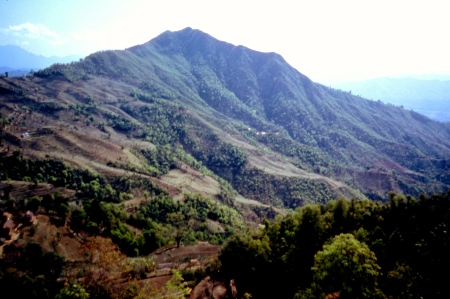
Click to Enlarge. The missionary compound, including the hospital, can be seen shining in the sun, about the middle of the photograph. [Photo by Author]
In 1993, she returned to Edmonton where I was now working for CBC Radio News.
THE AMP PIPAL COMMUNITY HOSPITAL TODAY
A German NGO [non-governmental agency], NepalMed, now runs the hospital — with direction from the Nepalese government. Through donations, NepalMed buys medical equipment and helps pay for upkeep.
The following three images of the Amp Pipal Community Hospital are pulled from the hospital’s website … http://www.amppipal.de. Website? It seems weird that a hospital in remote Nepal has a website, but there you go. Notice the address of the website: de, which means it is located in Germany.
I can see that Helen’s old hospital has expanded from my time there in 1981. The building is more modern and the equipment has improved.

Amp Pipal Community Hospital – Circa 2014 [image supplied]

Doctor Huston has praised the new hospital administration for making improvements to the facility … and for increasing the level of care. [image supplied]

[image supplied]
REPORTER AND DOCTOR REUNIONS
Helen and I get together every now and then, more so lately than in years gone by. We talk about old times and new times.
The first time I saw Helen after she retired, she was hunched over on a sidewalk in front of her apartment. She’d slowed down and the years were showing. I’m sure she thought the same of me.
In 1995, I phoned to see if she wanted to get out for tea and biscuits. “Sure,” she replied. When I arrived, Helen wasn’t quite ready and so I waited in her living room. To pass the time, I walked around and checked out posters and pictures that covered her walls, snapshots of old friends and colleagues. Not surprisingly, the scenic shots were of Nepal.
What I was looking for was the Order of Canada medal Helen had recently been given. I couldn’t find it.
“Where’s this Order of Canada?” I asked. Out came Helen from a back room, mumbling, “Now, what did I do with that? …” Hmmm. Most people would have had the award framed and on display. Not this woman.
Helen rummaged through some drawers, pulling out this and that. “There it is!” she exclaimed, turning my way.
Here was the country’s most prestigious medal and Helen had it stuffed away in a drawer.

Doctor Helen in 2002 [supplied]
There were other emotional changes in Helen’s life too. She’d quit the United Church and joined the Baptist Church. However, she remained heavily involved in church causes.
One night she phoned, asking if I could do something to stop the killing of young Somali men in Edmonton. I said, “Helen, these shootings are all drug-related.” It didn’t really matter to me. Actually, I couldn’t care less. But to Helen it did matter. She wanted to know if I could talk to the drug dealers and try to stop the killings. Helen longed for the deaths to stop.
Around noon on Thursday, 21 August 2014 Helen and I drove to Edmonton’s River Valley, a beautiful park with tall trees and trails. We sat on a picnic bench in a clearing. Save for the noise of the odd siren and the rumble of a transit train, it was a country setting in the middle of a big city.
We talked for more than an hour — mostly about Jesus. Surprised? Helen did most of the talking, for which she apologized. No problem.
In this one minute clip, Helen talks about Her Saviour and His forgiveness …
The good doctor and I have a habit of phoning each other on March 4th. Years ago I had called her on that day and said, “You know, Helen, today is the only day of the year that’s a command!” “Huh?” she said. “Yup. March forth!” It’s become a private, annual joke.
It’s hard to say how many ‘march forth’ jokes we have left. On one of the last times we spoke, Helen revealed she was a member of what she called a “geriatric club.” “We’re all dying,” she said, with a tone that spoke more of exasperation than revelation, “… and these guys don’t know the way.” It reminded me of the bumper sticker, “Friends Don’t Let Friends Die Without Jesus!”
On Thursday, 21 August 2014 I dropped around to her apartment. I pulled up a chair at her small kitchen table. On the table was something that brought back pleasant memories of our first meeting, in Nepal, decades ago: fresh-cut amaryllis. “Smell these,” she said, pulling the flowers closer to us.
She asked if I wanted anything to drink. “I’d like a nice cold beer.” She smiled and said, “That sounds familiar …”
I asked Doctor Huston if she had any regrets, pointing out that most doctors who graduated in her class [well, those who are still alive] are better off financially … with lake-side cottages, trips abroad, air-conditioned homes, comfortable lifestyles … all that. She looked my way and uttered just three words: “I am rich …”
When I left her apartment I took note of a drawing on the back of her door, and so I snapped a picture of it with my iPhone. When one thinks of the adversities in our lives — in particular the life of Doctor Helen with her challenges and setbacks in poor countries overseas — this cartoon pretty well sums things up.
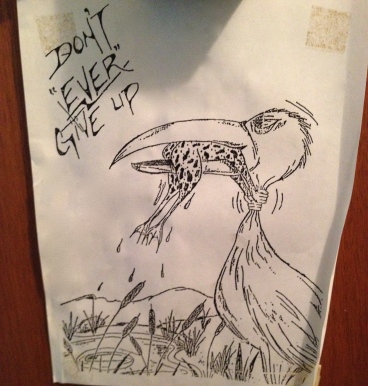
A drawing with an inspirational message on Helen Huston’s apartment door in Edmonton. [Photo by Author]
AN EVENING WITH DOCTOR HELEN
It was entirely ‘spur of the moment.’
I went around to Doctor Helen’s apartment on Tuesday evening, 25 November 2014 with a small gift: A pair of safety spikes for winter footwear to help prevent the old gal from slipping on the ice and hurting herself. Old people, brittle bones, etc.
We spent a good 15 minutes or so trying to figure out how the contraption attached to her boots [we’re both seniors, remember] … but once we got that sorted out, we were good to go.
But wait. Helen had a couple of things she wanted me to take care of. One job was to install a chain on a ceiling light in a small storage room, the other was to put a screw in her dining room wall so that her clock could be hung properly. Easy stuff.
We walked to my car in the dark parking lot with Helen holding onto my arm for support. At one point she remarked how beautiful it was: cool air, clear sky … with a soft glow from the street lights highlighting the snow-covered evergreen trees.
We drove to a Tim Hortons coffee shop, about a mile away. Inside, Helen continued to hold onto my arm as we gave the cashier our order: soup, buns, hot chocolate and French vanilla coffee.
“This is my girlfriend,” I said to a puzzled-looking cashier. Looking around the crowded shop, I added, “… just hope her husband isn’t here! …” The highly religious Helen, leaning forward to make her point, quickly countered. “He’s only JOKING!!”
After we took our seats, Helen spoke about a man [a “non-believer”] who once gave a talk at her church on a book he’d written — about God — and how that book had “led thousands to the Lord.” “Maybe you’d like to read it,” she offered. I said, “Fine with me.”
I gave Doctor Huston a 17-ounce jar of Tim Hortons hot chocolate, a gift from Don Hume of Campbellton, New Brunswick. Helen asked, “Would you please put Don’s name on the lid so I’m reminded it’s from him?” I did just that.
We returned to Helen’s apartment, but I didn’t stay long; I had chores to tend to.
I pulled out my iPhone and snapped this shot of Doctor Helen Huston resting on her walker …
As I opened the door to leave, it occurred to me that we should talk a bit more about my quip to the cashier at Tim Hortons. “Hope I didn’t get you in trouble,” I said. “That’s all right,” she assured. “What I mean,” I went on, “… is that I hope she didn’t think you were chasing young men!”The good doctor tilted her head back and laughed out loud, just the way she did in Nepal many years ago. “Helen, there’s only ONE way to get around this problem of yours,” I offered, “… you should go to church more often.”
‘A HEART FOR NEPAL’
For the definitive story of Helen Huston, read the book A Heart for Nepal: The Dr. Helen Huston Story, written by Doctor Gerald Hankins of Calgary. Hankins, a notable surgeon and missionary, served 12 years in Nepal.
The man spent considerable time with Huston in both Nepal and Alberta.

Gerald and Allison Hankins pictured outside their home near Kathmandu in 1981. Gerald died in 2020. He was 97. Allison died in 2009 at the age of 82. [photo supplied]

A Heart for Nepal – 1993 [Amazon]
At the time of the assignment, I ‘ate and slept’ Nepal. Nepal was always on my mind, and I was often trying to find ways to sell a story on Huston or Nepal to make a living. I simply got fed up with it. About 20 years would pass until I had the interest to see any of the hundreds of slides I’d taken while over there. This was clearly a case of “overdoing” a project.
ALBERTA ORDER OF EXCELLENCE – 1994
Here’s an interesting video of Doctor Helen’s work in Nepal [produced by the Alberta Government in 1994]. Included is an interview with the retired missionary.
https://youtu.be/lGcRxkdnJqQ
MORE RECENT IMAGES OF AMP PIPAL
![2014 Google satellite shot of Amp Pipal [circled is the hospital complex]](https://byronchristopher.files.wordpress.com/2014/08/screen-shot-2015-04-27-at-10-01-48-am.jpg?w=549&h=367)
2014 Google satellite shot of Amp Pipal [circled is the hospital complex] Click to enlarge. [image courtesy of Google]
EARTHQUAKE – 2015
On Saturday, 25 April 2015 a massive earthquake struck Nepal, claiming thousands of lives. The quake — measuring 7.8 on the Richter scale — was the worst ever to hit the small country.
The epicentre, halfway between Kathmandu and Pokhara, was near the community of Lamjung. Lamjung is about 15 kilometers northwest of Amp Pipal — “as the bird flies.”

The red dot indicates the epicenter of the quake. Amp Pipal [located in the Gorkha region] is about 15 kilometers from the epicenter. [Courtesy of Google] Click to enlarge. [image courtesy of Google]
According to Amp Pipal native Birod Wagle, however, it was a totally different story in the nearby communities of Simpani, Ratdada, Darimchaur and Boharagaun. There, says the Kathmandu-based chartered accountant, most of the houses were flattened.
There was little damage to the hospital at Amp Pipal. “Just a few cracks,” reports Doctor Huston after new information arrived from a contact in Nepal on Monday, 27 April 2015. The source: Chris Hale, who spent his youth in Amp Pipal. His father, Tom Hale, was a surgeon at the Hospital.
“That’s great news,” Huston says, of her old hospital being spared, “the prayers of many have been answered. Hallelujah!”
The hospital is now trying to treat many who were hurt in the earthquake.
It was a job and a half trying to get information on the status of the Village of Amp Pipal and the hospital.
On the morning of Sunday, 26 April 2015 — and on the following day — I placed calls to a cell phone at the Amp Pipal Hospital [which has spotty phone service at the best of times] — but there was an immediate busy signal, which may indicate the mobile phone is out of service. I’m not sure how that works.
I also put in numerous calls to Nepalmed, the organization in Germany that now runs the Amp Pipal Hospital. No one picked up.
I then placed a message on the Facebook page of the Amp Pipal Hospital.
On Sunday morning [Edmonton time] I put in calls to both Doctor Helen Huston [Edmonton] and Doctor Gerald Hankins [Calgary] but at that point, neither had heard a word from Amp Pipal.
That same day [Sunday 26 April 2015], I spent much of the afternoon with Doctor Huston, at her apartment. We spent hours on the phone with a long-time foreign development worker and friend of hers who spent 25 years in Nepal, including three years in Amp Pipal: Walton [and Ruth] McCaslin of Meyronne, Saskatchewan, Canada.
Walton McCaslin emailed Huston photos showing damage in Amp Pipal. McCaslin found the images on the Facebook page of Doctor Ian Smith, who had also worked in Nepal. The photos were taken by Suman Shrestha. And that, folks, is how social media works.

Liglig Mountain can be seen in the background. [Image courtesy of Suman Shrestha, Ian Smith and Walton McCaslin]

Doctor Huston at home in Edmonton watching a video showing workers in Nepal rescuing three men who had been trapped in the rubble of a collapsed building. Image taken by Author on Sunday, 26 April 2015. [Photo by Author]
Click here http://www.businessinsider.com/drone-footage-shows-utter-devastation-after-massive-nepal-earthquake-2015-4#ixzz3YY9UpXKi for a Business Insider story on the quake devastation in Nepal. The article contains video shot from both a drone and from a helicopter. Thanks to broadcaster Randy Marshall of Edmonton for this piece.

A second major earthquake struck Nepal on Tuesday, 12 May 2015, registering 7.3 on the Richter scale. The epicenter was about 45 miles east of Kathmandu. [Photo by Author]
One survivor told USA Today that being in the earthquake was “like being on a boat in high seas.”
The quake also killed people in neighbouring India [at least 72] and China [at least 25]. Those were the early figures.
For George Varughese’s eye-witness account of the earthquake in Kathmandu, click here: http://asiafoundation.org/in-asia/2015/04/29/in-quakes-wake-the-price-of-political-disarray/

Isaiah 55
HOSPITAL STAY
On Tuesday, 17th November 2015, Doctor Huston was put on a stretcher and taken by ambulance to the Misericordia Hospital in Edmonton’s west end.
She wasn’t terribly happy about it. It was her neighbour from across the hall, Linda Murray, who noticed that Helen was in distress [severe back pain] and she phoned 911. Friends do that.
People calling Helen’s phone number got no pick-up, and emails sent her way went unanswered. Few were aware of what had happened.
The following Sunday, I received emails from two long-time supporters of Doctor Helen — one in Saskatchewan, Canada and the other in Nepal. They wanted to know what was going on.
That’s how I spent the better part of Sunday, trying to find the answer. I called Helen’s apartment; no response. Went around to her building and buzzed her unit. No answer. I then went to a Baptist church where she’d gone in the past. She wasn’t there, but I sat through the service anyway so I could speak with the preacher, Rev. John Cline. He didn’t know what was up but promised to get back to me if he did hear anything.
Next stop was a return visit to Helen’s walk-up apartment building. A random buzz of units on her floor led to a meeting with Ms. Murray — the one who’d called for the ambulance. As I was pulling away from the apartment complex, I spotted John Carlo, another good friend of Helen. We chatted.
Carlo was aware that Helen was in the hospital but he didn’t know much more than that. Then Carlo revealed a secret — that he sometimes dropped off fried chicken at Helen’s apartment. “She likes fried chicken,” he said, with a grin that suggested she loved it.
I drove around to the Misericordia Hospital to meet Helen — but not before I made a quick stop at a Mary Brown’s chicken outlet nearby.
I walked into room #703 to find Doctor Helen sitting on a chair in the corner. On a chair beside her was a preacher [whose name was Robert]. The two had their heads bowed in prayer.
The preacher wasn’t there long and to a surprised Helen I said, “Guess it’s my turn …” She asked about the package I was holding. “Food,” I said. “They feed us here, you know.” “Not like this,” I said. In seconds, Doctor Helen was devouring the fried chicken.
“Did you bring anything to drink?” I slipped her a bottle of cold orange juice. The snack was again compliments of Don Hume of New Brunswick.
Helen talked for only a few minutes when an old friend, a retired nurse, walked in the room and announced she was taking Helen for a walk. I left soon after, but not before I squeezed Helen’s hand and wished her all the best.
I did not mention pancreas and neither did she.
For the time being, the prayers of her friends and former work colleagues have been answered.
I was around to the hospital to see Doctor Huston half a dozen times — and only once did she not have company. It was like a pilgrimage. I told her she likely owed a lot of people money.
ON THE MOVE …
In early March 2016, Doctor Helen moved into an ‘independent living’ senior’s complex in South Edmonton.
She was liking it there. The old gal no longer had the Internet — but she did have her own apartment, the BBC and lots of interaction with other residents.
A VISIT TO THE RIVER VALLEY …
In the summer of 2016, I dropped around to Helen’s apartment and we went for a spin.
Our first stop was a fast-food outlet where we got a hot tea and a biscuit, then we went to a park in Edmonton’s river valley.
TURNING 90
On 20 September 2017, dozens showed up at Doctor Helen’s retirement home in south Edmonton for a private ceremony to congratulate the medical missionary on turning the Big 9-0.
Helen moved around the room, spending one-on-one time with each of her guests. She hugged them all. Many wanted their picture taken with her.
Included were relatives, medical doctors, missionary workers and church parishioners. Here’s a group shot taken towards the end of the 2-hour event.

Doctor Helen wore a traditional Tibetan dress. The gentleman seated on the far left is 101. [Photos by Author]
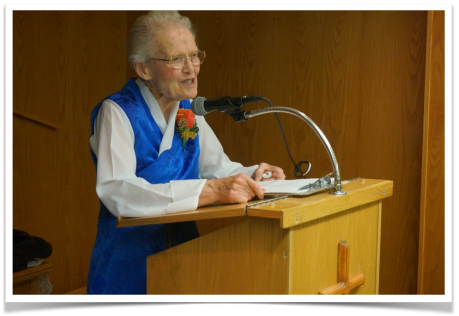




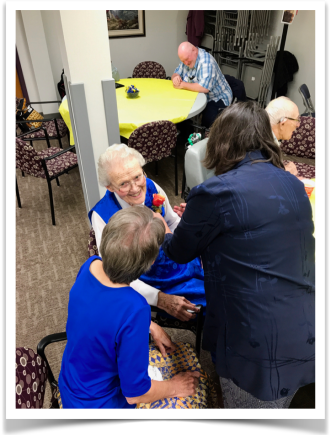

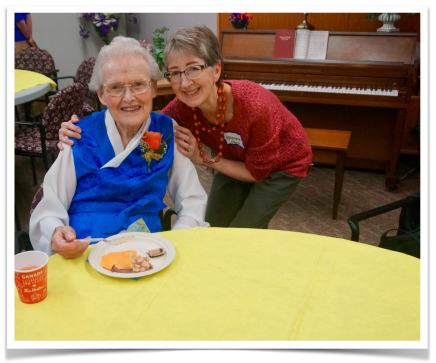

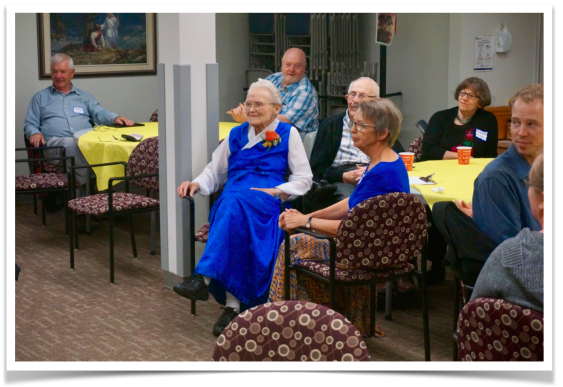

To view the 0:17 clip, first click on ‘share’ [top right], then click on either ‘original file’ or ‘MP4.’
In this 0:53 clip, long-time friend Robert Priest delivers grace … same thing … hit ‘share’ then ‘original file’ or ‘MP4’ … [wait for it to load]
ON THE MOVE AGAIN … AND AGAIN
Doctor Huston was hospitalized [at the Grey Nuns Community Hospital] in April 2018 after a series of falls in her apartment.
She left the hospital on Friday, 11 May 2018 for a new home: the Good Samaritan Society Southgate Care Centre on Edmonton’s Southside.
I last saw Helen on 25 July 2019. I dropped off one of her favourite treats — a jar of nuts from Costco … and in return she gave me a treat: a tour of her backyard where dozens of beautiful flowers were in full bloom.
Maarit Härkönen of Finland [a former missionary at Amp Pipal] describes the flower patch as Helen’s own ‘Garden of Eden.’ [See photo below]
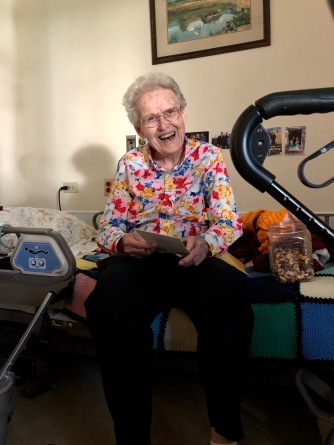
Dr. Helen’s reaction to a funny birthday card on 19 September 2019. She had just turned 92.
DEMENTIA …
When I dropped by to visit Doctor Helen in early September 2021, I hadn’t seen her in well over a year [because of Covid]. Helen had put on some weight but, more important, she appeared to be battling dementia.
Helen’s memory is going. She knew who I was — at least I think she did — but she had no memory of her hospital in Nepal.
Helen was excited to get a 2022 calendar — but ten minutes later, she was totally surprised to see the calendar again. It was as though she had no short-term memory. I’m no doctor, but these aren’t good signs.
Through it all, Doctor Helen remained friendly, grateful and concerned about people … and flowers — and in love with Jesus. Such is the depth of this woman’s faith that even dementia, if that’s what it is, keeps its distance.
HELEN’S HOSPITAL IN 2021
Courtesy of the Friends of Amp Pipal Facebook page …
A VISITOR FROM AFAR ARRIVES WITH ROSES
Margaret Muller, a Christian from South Australia had, for many years, admired Doctor Huston from afar … but on a bright, Saturday afternoon, October 15, 2022, Margaret walked up to the long-retired missionary in her nursing home in South Edmonton and announced, “It’s an honour to meet you, Doctor Helen …”
The good doctor, battling dementia, loved the recognition, the warm hug and the red and white roses Margaret delivered.
The pair talked up a storm like they’d known each other for decades …
Within minutes, Margaret was wheeling Doctor Helen outdoors to enjoy the fresh autumn air, a not-a-cloud-in-the-sky Autumn day one would see on postcards.
What a beautiful day, and a beautiful outing. I hadn’t seen Helen in more than a year, and I wondered what she’d be like when I showed up that day, with a stranger no less. Turns out, after Margaret presented Helen with some beautiful flowers … and the two went for an unscheduled walk in the sunshine.
Helen really enjoyed herself. I hadn’t seen her smile like that in ages.
‘Tis true … the Lord does work in mysterious ways.
JUNE 29, 2023
I dropped around to see Helen in late June 2023. I found my old friend in an exercise class with a dozen other seniors, all in wheelchairs and strollers, performing very basic exercises … moving their limbs, etc. Helen, now 95 mind you, was one of the least active in the group. Long after the instructor had participants pretend they were playing the piano [finger movement], Helen continued to move her fingers back and forth.
Yes, it was sad to see that.
But this is simply what four decades can do to my memory of a spry Canadian doctor bouncing up steps to her humble abode at Amp Pipal. I was not only watching Helen in action, I was also wondering what I would be doing 15-20 years from now.
One of the facilities’ therapists suggested I bring Helen to the backyard, a private, fenced-off area with flowers, a beautifully manicured lawn and cemented paths. Perfect. Helen so enjoyed being outside in the sunshine. A highlight was when she spotted a wild rabbit. “Look!” she exclaimed. Up until then, she hadn’t said a word.
You’re wondering if Helen remembered me. She did not — but so what? What mattered is that I remembered her.
We returned inside and said our goodbyes. Helen Huston may be “losing it mentally,” but not her manners. “Thank you,” the smiling doctor said repeatedly.
HELEN’S DEATH …
On February 22, 2024, I dropped around to see Dr. Helen. She was asleep and I woke her up. Canada’s best-known medical missionary slowly looked my way and her eyes met mine. I could tell she was wondering who I was. “Helen,” I said, “I met you a long time ago … in Nepal …” That brought a weak smile.
I held her hand. Another smile.
Doctor Helen didn’t talk; she whispered in the weakest of voices. All I could make out was, “God bless you.” Surprise. I was in tears but I smiled anyway.
Helen nodded off. I had known the good doctor for half a century, and it was the first time I ran my fingers through her hair to comfort her. It was my way of saying ‘thank you.’
Helen was in the final days of an outstanding life.
Doctor Helen took her final breath on Friday evening, March 1st. That afternoon, two dear friends from her apartment days in South Edmonton dropped by to spend time with her: Giancarlo Grande and Darleign Horton. The two gave Helen precious company in her final hours.
It was Doctor Helen’s nephew, Darrel Ellenwood, who notified me of her passing.The next morning, the story was broken by two Edmonton radio stations, CHED and CFCW. Here’s JT Lemiski, friend and reporter, at CFCW ….
There must have been a tremendous celebration in Heaven when Doctor Helen Huston “crossed over.” That is when Helen would’ve met her hero, Jesus. What I would’ve given to have seen that. I’m not sure who would have been more excited, Dr. Helen or Jesus …
Well done, Helen, well done. You made us all proud.
DR. HELEN’S LEGACY
It’s hard to describe what Helen Huston has accomplished in her life. It’s not been easy. I hope this post helps explain the Alberta medical doctor who gave up a comfortable lifestyle and moved far away to a poor country — just to help others.
Mission accomplished.
Thank you, Helen Isabel Huston for all you’ve done to push humanity in the right direction.
FUNERAL
A funeral service for Doctor Huston is scheduled for 1 PM. on Saturday, April 6, 2024 at the Capilano Christian Assembly in Edmonton. The plan is to “live-stream” the service on Facebook.
Her obituary appeared in the Edmonton Journal on 16 March 2024.
THE AUTHOR
https://en.wikipedia.org/wiki/Byron_Christopher


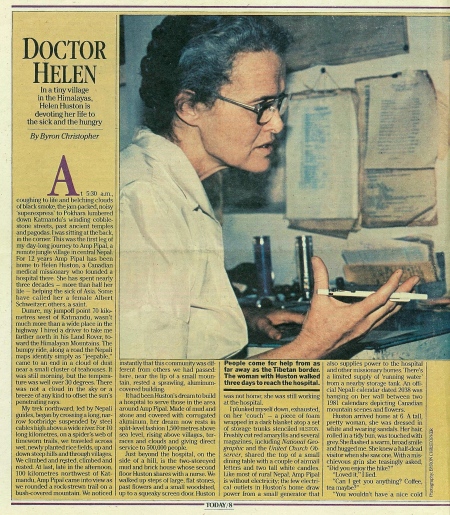






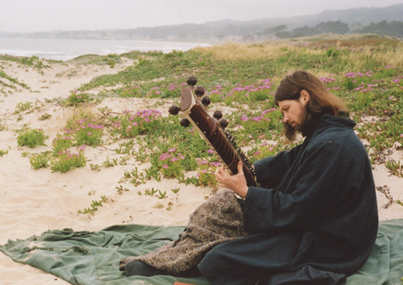







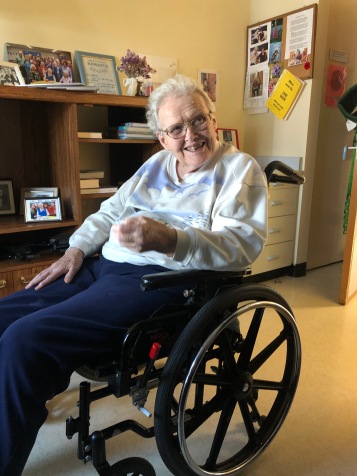







Byron, every post is better than the one before. You are a masterful storyteller. Thanks for the update on Dr. Helen and a few lines that made me smile ear-to-ear (you can guess which lines). Cheers.
LikeLike
As usual, your personal stories are really the greatest.
Nepal was one of the places I wanted to visit, but never got around to it.
Now it is to late for me.
Thank you for sharing.
LikeLike
Great story, not many get the chance to do a story like this.
LikeLike
I remember you telling me this story several years back, but I still enjoyed the written story and photos.
Love your many fancy quips.
LikeLike
l miss Doctor Helen, not only me but my family and all of our Amppipal village. She always took care my brother Nirmal Shrestha.
LikeLike
I really miss you Helen!
LikeLike
She’s the best doctor. She served a lot of poor people who lived in the remote areas of Lamjung, Gorkha, Manang and Tahanu.
She was so kind, skillful and polite.
I miss her.
LikeLike
I have been so happy, amidst such sorrow about Nepal, to read your post about Auntie Helen. I have had a couple of opportunities to visit her at her little apartment (since I returned from South Asia myself) and the way in which you have described your visits with her, have brought back to me how incredibly wonderful it is to know someone like her.
I also enjoyed the photos of the children because they were my childhood friends in Amp Pipal and I have very few photos of them. I was 13 years old in 1981. Most of them (in the group picture) are my Facebook friends now and have reported themselves “safe.”
Thank you so much Byron.
LikeLike
Is there any up-to-date information on Amp Pipal and the hospital?
LikeLike
Hi Sue,
I’m told that the hospital at Amp Pipal had little damage [cracked walls and such]. However, staff was swamped trying to look after the injured. I’m also told that a village not far away had severe damage, with injuries and a number of deaths.
It’s difficult at the best of times to get information out of Kathmandu, but for the communities in the sticks, it’s that much harder.
Byron
LikeLike
Convey my Namaste to Dr. Helen.
My parents and grandparents told me that, after the establishment of Amppipal Hospital and School in Amppipal, everything changed. Many people were given new life with the service of Dr. Helen and company.
Still many people here say that they would have died at early age, had the Hospital not been established.
Thank you very much for covering story of Dr. Helen and Amppipal. Byron, I appreciate your concern and love for Amppipal.
I hope Dr. Helen is well. Our prayers are with her.
I wish I could meet Dr. Helen once in my life.
God bless you both.
LikeLike
Namaste to Dr. Helen Huston.
This is Rabindra from Dumre, Nepal. I loved your story, beautiful photos and everything. So happy to know that you spent some time here in Nepal in 1981.
I saw one photo of my place, Dumre. That was a very old picture. Love to see it today.
Many thanks for uploading these pictures and everything. God bless you.
LikeLike
Really well-written; thanks, Byron.
Doctor Helen delivered me through c-section in 1965 at Ampipal Clinic, where my parents Thomas and Mary Varughese served alongside her for UMN. She named me Anand at birth.
It would be good to be in touch.
LikeLike
I worked as a nurse in the operating room in Amp Pipal; left to return to Finland in the spring of 1980.
I will never forget the people and that time there! It was so full of something very, very special — and I was not mature enough to understand all that then ….
It was just GREAT to read your article and thoughts about Doctor Helen and her life and work!
Special thanks for the clip of Helen talking about our Saviour and His forgiveness! It is so strengthening to hear all that with Helen’s warm and soft voice, which I still remember so clearly.
So sorry to hear about that cancer. Please give my warmest greetings and a hug to Helen. Among her many, many friends around the world — as well as here in Finland — I am remembering her in my prayers.
LikeLike
I worked a few years (1986-1989) in a little village that belonged to the Gorkha Project. I will always remember our lovely Helen — “Doctor of Amp Pipal.”
“That’s so beautiful” was her favourite expression when someone told her something, and she listened to everyone.
I agreed all with what Maarit wrote. We all remember her in Finland.
We have had family camps for the Nepali people in Finland. There are many Nepali restaurants in Helsinki so we can always enjoy tasty dalbhat.
Thanks for this lovely story and pictures … many good memories from Amp Pipal and “Doctor Helen.”
Blessings and hugs to her and to her many friends around the world.
LikeLike
Pingback: Dead Man Under a Pool Table | Byron Christopher
Thank you for a wonderful article.
I was delivered by Helen in Amp Pipal in the 1960s when my parents, Howard and Betty Barclay, were colleagues of Helen.
Helen was very special to us children growing up.
I have tried to send Helen emails from my parents the last few years but they always bounce or no reply. I would love to be in touch and wonder if you could send me a current email, or a way to contact her.
Please pass on our special greetings to her.
LikeLike
Contact information has been sent to Margie.
LikeLike
It was just great to read your articles and thoughts about Ampipal and Doctor Helen.
I was delivered by Doctor Helen in Ampipal in 1964.
My parents, Jagat Bahadur Shrestha and Jagat Maya Shrestha, have already passed away.
I would love to be in touch and wonder if you could convey our regards to Doctor Helen. Please give my warmest Cristmas greetings and hugs to her.
LikeLike
Many thanks for this wonderful link to Helen. We worked with her from 1987-1992 in Amp Pipal, for five glorious years.
Please send her our love and warmest greetings.
LikeLike
I was a tutorial group teacher in Amp Pipal after Doctor Helen retired. She also visited Amp Pipal over Christmas while I was there. It was incredible to walk around Amp Pipal with her and see the love the villagers had for her.
Helen saw me off at the Edmonton airport when I left for Nepal … and she met me when I returned home.
We live in Saskatchewan and have visited Doctor Helen when we passed through Edmonton.
Would you please send me her current address?
LikeLike
Contact information has been sent to Valerie.
LikeLike
Hello Dr. Helen,
Greetings from the Nepali people!
There are no words to explain your courage to set up the Amp Pipal Hospital.
I am pleased to know your real life moments were spent over here. I salute your dedication and the saving of numerous lives that were in endangered and could be in demise if you would not there. Thanks.
Truly you are the real Hero who left her birth place to medicate the people far in the horizon.
It does not matter who runs the hospital right now, the fact is YOU who are the founder of this hospital and you alone. You gave birth to this hospital and its medicare to the citizens.
I wish you good health and that you always prosper. Many thanks, and thanks to Byron Christopher for posting the article.
LikeLike
When I was a Camrose [Alberta] Lutheran College student, myself and 2 friends, Dorothy and Sylvia, stayed with Pastor Wil Huston for the summer in Camrose. We took care of his meals and his home … and we could stay there at no cost while we worked at Bethany Care Centre to earn money for university.
We heard a lot about Dr. Huston. He was immensely proud of his daughter.
I would love to chat with her.
LikeLike
Dr. Helen, I wish you health.
LikeLike
Many, many warm thanks for this wonderful update!
KIITOS!
LikeLike
How wonderful! She looks fantastic!
LikeLike
Dr Helen is a source of inspiration for many people.
Dr Badri
Professor of Ophthalmology
Nepal
LikeLike
Greetings from Ruthie.
Carry on in God’s grace!
LikeLike
No words can express my gratitude to Dr. Helen. I am very much inspired by her story.
I was a child when she visited my home on the way to the hospital and left a picture that she took of our family. I wish I could see her again.
LikeLike
I first met dear Helen in Amp Pipal in 1980.
Wishing Helen a great 90th year and Blessed Christmas!
LikeLike
Pingback: The Good Doctor and Me | Byron Christopher
Pingback: The Good Doctor and Me, by Byron Christopher - Easton Spectator
I just found this post after reading Dr. Huston’s biography. I hope she is still alive and doing well during this pandemic. If you see her please tell her that a reader in Kentucky, USA was touched by learning about her life in Nepal.
LikeLike
I am from Melbourne Australia and my parents were in Am Pipal when Dr. Helen arrived there. My Father was the project director and worked with Helen in planning and establishing the hospital. In fact, Helen helped to deliver me when I was born there some time before there was a hospital (in The Big House — where she originally lived) – in 1960!
I did appreciate reading your artivcle and in fact did share it with my parents when I first came across it.
I have wanted to know how to contact her for some years now as the email my parents had was no longer accessible to her. My parents have both passed away in 2017 and 2019. I would love to be able to send her a letter or any other means to communicate and be in touch. Helen was a special part of our families lives and myself and my siblings have many wonderful memories from those early years.
LikeLike
Helen is doing well, although she’s been under ‘house-arrest’ because of the Covid-19 flu. I spoke with her a couple of times by phone, although I’m not allowed into her facility because of the outbreak.
More than two dozen seniors at her residence have died because of Covid-19 complications.
LikeLike
HI Byron,
It’s Giancarlo (Johncarlo) here. How are you doing? I am fine. Do you remember me? I am Helens friend from her apartment in Lansdowne.
I am still good friends with Helen and I call her as often as I can. It takes her a bit oh, but our conversations are always good and they end with a lot of chuckles. Helen and I have a special relationship and when I call her we generally talk about nothing and just laugh.
Before the covid I would often take Helen out to see the geese down at the pond at the Research Park. She absolutely loved this. We also took her out to Swiss Chalet once and as usual she loved her chicken meal. Last time I talked to Helen I told her the first thing we will do when she is allowed out is that we will head straight for Swiss Chalet. She had a good chuckle. I always try to cheer her up and make her laugh.
Thank you for writing a good story about the good doctor. When I first met Helen I didn’t know that she was a doctor. She was just my Elder and needed a bit of help with her computer. This is where our friendship grew out of.
Just an FYI for you … if you didn’t know already that the good doctor also loves ice cream. Take care.
LikeLike
Great letter! Best wishes.
LikeLike
Namaste, I am very glad to see this blog and the wonderful details of Helen Huston.
She has saved many people and I am one of the people from Amppiptal Nepal.
I have been inspired by Doctor Helen to live for others.
LikeLike
डा. हेलेनले बिरामीको लागि भगवान बनेर आँपपिपलमा आफ्नो जिवनकाे उर्जाशिल समय दिनुभएयाे यसकाे लागि म र मेरो परिवारकाे तर्फबाट धेरै धेरै धन्यवाद ।साथमा सबै डा. र मलाई माया गर्ने शिक्षकहरु टाेनि र एल्सी गुुरुआमाकाे धेरै संझना आउँछ ।तर अहिले सम्पर्क गर्न सकेकाे छैन।काेहि बाट सम्पर्क ठेगाना पाउने अपेक्षा गरेकाेे छु कृपया।
Translation [thanks to Goggle]: Dr. Many thanks on behalf of me and my family for giving Helen the energetic time of her life in Amapipal by becoming a God for the sick. And I miss my dear teachers Tanny and Elsie Guruma a lot. But I haven’t been able to get in touch right now.
LikeLike
Byron, thank you for this excellent write-up. I really appreciate, as does everyone who knows Helen, your faithfulness to Helen and her story.
LikeLike
Byron, thank you for the gift of sharing your longtime friendship with Dr. Helen.
I was in all those places in the fall of 1991 — a freelancer in collaboration with Dr. Gerald Hankins who authored the Heart for Nepal book.
I regret that I never managed to keep up with Helen after her retirement … so am thankful for your reports that restore “the years the locust has eaten.”
LikeLike
Our dear Doctor Helen has gone Home to be with her Lord Jesus.
An amazing woman of God, and an amazing woman for humanity.
I was enthralled with this wonderful lady when I read Byron Christopher’s story. Her whole life was lived for God’s glory and for easing people’s pain and suffering.
It was my joy to meet her and spend time together, in one short week of my visit from Australia in October 2022. It was a real blessing for me.
Doctor Helen and I talked, laughed and enjoyed a walk in the sunshine.
She will always be in my heart of memories.
LikeLike
Thank you for sharing this news. Helen was passing through AmpPipal ( before the hospital ) and happened to be on hand for my entry into the world!!🙏. What a blessing for our family back in 1960 and over the years since. A wonderful woman, a godly example, full of fun and a life dedicated to simplicity, to God and to others. Fondly remembered with gratitude and thanks ❤️
LikeLike
So grateful to God that I was able to read from the Bible for Helen, pray and hold her hand the day before she died. Helen was a faithful follower of Jesus Christ and a wonderful example and encouragement to so many of us in her retirement.
I can only imagine the huge impact and blessing she was to the people of India and Nepal.
Rejoicing that Helen is with Jesus.
LikeLike
It was an honor to have known her and finally to visit her in June 2023 and sing Nepali songs and pray with her.
LikeLike
Thank you for your very human and inspiring articles about Dr. Helen over the years. I have only recently found them, but they have been uplifting and delightful to read.
Thank you for sharing your personal encounters with such a remarkable woman. It has made her into a complete person, full always of her deep love for and faith in Jesus, but also full of humor and humanity. You have presented the wonderful person we knew and loved.
Thank you for your last posts. They were full of compassion, respect and love.
LikeLike
Thank you very much for your very inspiring coverage of Dr. Helen’s life and ministry. You have been a true friend.
She will always be remembered for her deep love for Jesus and her compassionate care for others. Even after coming back to Canada, she continued to live a very simple life. I remember visiting her at her Lansdowne apartment with all the memorabilia from Nepal. She would often showcase them when we celebrate “Christmas around the world” at Riverbend (now Ambleside) Baptist Church. It must be hard giving up most of these precious souvenirs when she had to downsize and move to the senior facility.
I remember visiting her at the Misericordia Hospital one time, and she revealed that she needed salt in her diet (I did not know that was medical condition for real, or if she just wanted savoury fried chicken). She definitely had a witty sense of humor, and her hearty laughter is unforgettable.
I will surely miss Dr. Helen, but am assured that she is now resting in God’s everlasting arms. What a God-glorifying life!
LikeLike
Thank you Helen. Friends forever! Love you!
LikeLike